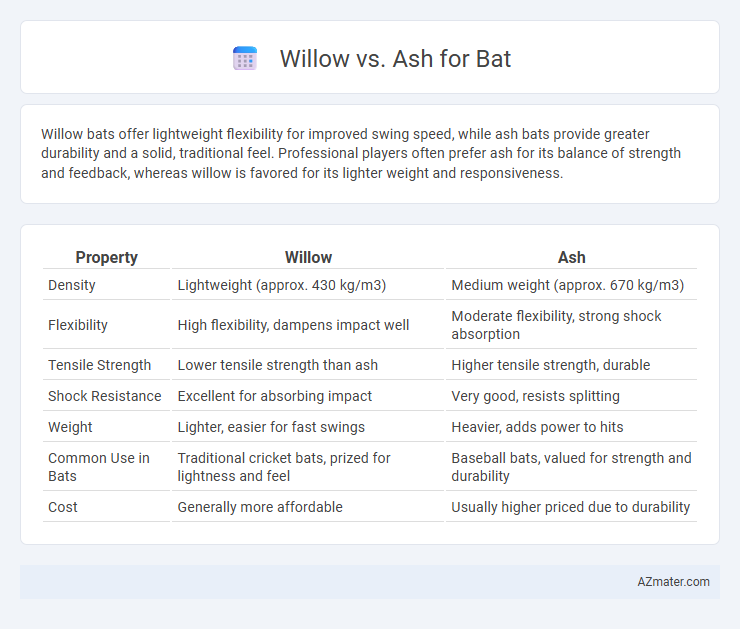Willow bats offer lightweight flexibility for improved swing speed, while ash bats provide greater durability and a solid, traditional feel. Professional players often prefer ash for its balance of strength and feedback, whereas willow is favored for its lighter weight and responsiveness.
Table of Comparison
| Property | Willow | Ash |
|---|---|---|
| Density | Lightweight (approx. 430 kg/m3) | Medium weight (approx. 670 kg/m3) |
| Flexibility | High flexibility, dampens impact well | Moderate flexibility, strong shock absorption |
| Tensile Strength | Lower tensile strength than ash | Higher tensile strength, durable |
| Shock Resistance | Excellent for absorbing impact | Very good, resists splitting |
| Weight | Lighter, easier for fast swings | Heavier, adds power to hits |
| Common Use in Bats | Traditional cricket bats, prized for lightness and feel | Baseball bats, valued for strength and durability |
| Cost | Generally more affordable | Usually higher priced due to durability |
Introduction: Willow vs Ash for Cricket Bats
Willow and ash are the two primary woods used in cricket bat manufacturing, each with distinct characteristics affecting performance. Willow, particularly English and Kashmir varieties, is favored for its lightweight, fibrous structure that offers excellent shock absorption and a larger sweet spot. Ash, known for its strength and durability, provides a heavier bat with a harder surface, delivering powerful strokes but less forgiveness on mis-hits.
Botanical Overview: Willow and Ash Trees
Willow trees (genus Salix) feature slender, flexible branches, narrow lance-shaped leaves, and thrive in moist, riparian environments, making their wood lightweight yet somewhat soft. Ash trees (genus Fraxinus) possess strong, dense hardwood with compound leaves composed of 5 to 9 leaflets and prefer well-drained soils, resulting in robust timber ideal for bat construction. The contrasting botanical characteristics influence the wood properties: willow offers shock absorption and flexibility, while ash provides durability and strength important for performance in bats.
Wood Grain Structure: Performance and Durability
Willow bats feature a straight, open grain structure that offers excellent shock resistance and a lightweight feel, providing superior swing speed and responsiveness for players. Ash bats have a more pronounced grain pattern with a harder texture, delivering greater durability and a stiffer feel but often at the expense of increased weight. Performance-wise, willow's flexible grain enhances power and control, while ash's dense grain promotes longevity and reliability under heavy use.
Weight and Balance: Player Preferences
Willow bats are often preferred for their lighter weight, allowing faster swing speeds and better control, while ash bats typically have a slightly heavier feel, offering solid balance and durability. Players seeking optimal balance may choose ash for its consistent weight distribution, enhancing power without sacrificing control. The choice between willow and ash bats depends on individual player preferences regarding weight sensitivity and desired swing mechanics.
Shock Absorption and Comfort
Willow bats provide superior shock absorption due to their softer, more flexible grain structure, reducing vibrations on impact and enhancing player comfort during play. In contrast, ash bats are stiffer and less forgiving, which can result in more noticeable hand sting but offer increased durability and a harder hitting surface. Players prioritizing comfort and minimal vibration often prefer willow for its ability to absorb shock more effectively.
Power and Stroke Play: Hitting Potential
Willow bats, crafted from traditional white or English willow, deliver exceptional power and a larger sweet spot, maximizing stroke play efficiency for powerful hits. Ash bats are lighter with a more flexible grain structure, offering increased bat speed and control but less raw power compared to willow. Players seeking maximum hitting potential and long-distance shots typically favor willow for its superior energy transfer and durability.
Longevity and Maintenance Requirements
Willow bats offer superior longevity due to their natural shock absorption and durability, making them ideal for prolonged use in competitive play. Ash bats are lighter but require more frequent maintenance as they are prone to cracking and warping over time. Regular oiling and careful storage can extend the lifespan of ash, while willow demands minimal upkeep to maintain optimal performance.
Cost Comparison: Affordability and Value
Willow bats generally offer greater affordability compared to ash bats due to the lower material cost and more abundant supply, making them an attractive option for budget-conscious players. Ash bats, while often priced higher, provide enhanced durability and a lighter feel that can justify the upfront investment for serious athletes seeking long-term value. The cost difference typically ranges from 10-30%, with willow bats being a cost-effective choice without significant compromises in performance for casual and intermediate players.
Popularity Among Professional Cricketers
Willow bats dominate professional cricket due to their exceptional strength and lightweight properties, with English and Kashmir willow varieties preferred for their superior performance. Ash bats are less popular among professionals because they are heavier and less responsive, resulting in slower swing speeds and reduced control. Data from international cricket equipment endorsements reveal that over 90% of top-tier players use willow bats for better power and durability.
Conclusion: Choosing the Right Bat Material
Willow bats offer superior performance with their lightweight and responsive grain structure, making them ideal for serious players seeking maximum power and control. Ash bats provide durability and a slightly heavier feel, favored by players who prioritize a solid, sturdy swing and increased bat speed through mass. Selecting the right bat material depends on the player's style, with willow suited for finesse and precision, while ash supports power and longevity.

Infographic: Willow vs Ash for Bat
 azmater.com
azmater.com